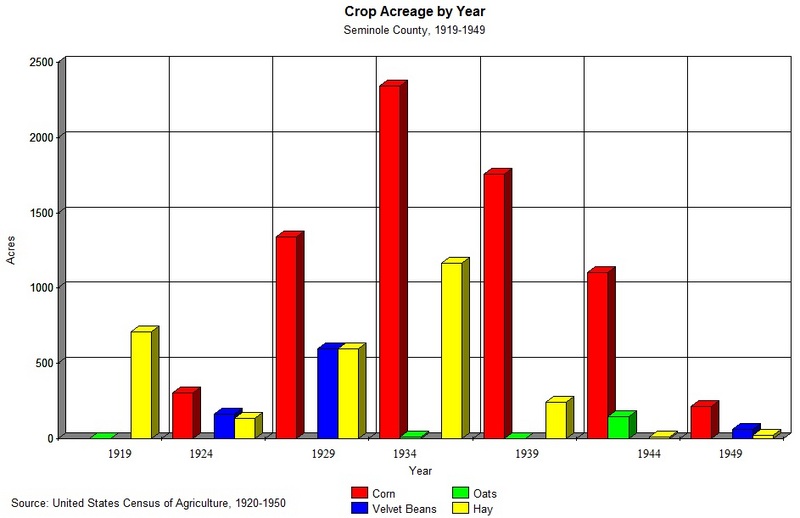Crop Acreage by Year, Seminole County, 1919-1949
Dublin Core
Title
Crop Acreage by Year, Seminole County, 1919-1949
Alternative Title
Seminole County Crop Acreage
Subject
Seminole County (Fla.)
Agriculture--Florida
Crops--United States
Vegetables--Florida
Vegetable industry
Description
Bar chart representing crop acreage for Seminole County from 1919 to 1949. Corn was often planted in the summer after the celery fields were harvested. Because the fields still contained fertilizer from the previous celery production, there was often a high yield of corn in Seminole County. In 1926, it was reported that most of the corn produced in Seminole County was a cross between Hasting Prolific and Cuban flint, a hardy type resistant to corn weevils. In the early-1900s, Seminole County was known for its agricultural development and close proximity to shipping lanes. By the 1920s, citizens in Seminole County, particularly in Sanford, soon shifted their interests in making the area a tourist destination.
Mosquito County, a massive county south of St. Johns County that consisted of much of Central Florida, was established in 1824. In 1845, Mosquito County was renamed Orange County when Florida earned statehood. This new county included present-day Osceola, Seminole, Lake, and Volusia counties. Orange County was named so for the area's major fruit crop: oranges. The area was devastated by a freeze during the winter of 1895-1896, which allowed for subsequent land speculators to initiate a land boom in Florida, with Orlando becoming a "boom town." Seminole County separated from Orange on April 25, 1913 and was named for the Seminole tribes that originally inhabited the area. In the early-1900s, Seminole County was known for its agricultural development and close proximity to shipping lanes. By the 1920s, citizens in Seminole County, particularly in Sanford, soon shifted their interests in making the area a tourist destination.
Mosquito County, a massive county south of St. Johns County that consisted of much of Central Florida, was established in 1824. In 1845, Mosquito County was renamed Orange County when Florida earned statehood. This new county included present-day Osceola, Seminole, Lake, and Volusia counties. Orange County was named so for the area's major fruit crop: oranges. The area was devastated by a freeze during the winter of 1895-1896, which allowed for subsequent land speculators to initiate a land boom in Florida, with Orlando becoming a "boom town." Seminole County separated from Orange on April 25, 1913 and was named for the Seminole tribes that originally inhabited the area. In the early-1900s, Seminole County was known for its agricultural development and close proximity to shipping lanes. By the 1920s, citizens in Seminole County, particularly in Sanford, soon shifted their interests in making the area a tourist destination.
Creator
Cepero, Laura
Source
Original bar chart by Laura Cepero, July 15, 2011.
Publisher
Date Created
2011-07-15
Date Modified
2013-10-02
Is Part Of
References
U.S. Census of Agriculture 1920.
U.S. Census of Agriculture 1925.
U.S. Census of Agriculture 1930.
U.S. Census of Agriculture 1935.
U.S. Census of Agriculture 1940.
U.S. Census of Agriculture 1945.
U.S. Census of Agriculture 1950.
Format
image/jpeg
Extent
94.2 KB
Medium
1 bar chart
Language
eng
Type
Dataset
Coverage
Seminole County, Florida
Spatial Coverage
28.727324, -81.204185
Temporal Coverage
1919-01-01/1949-12-31
Accrual Method
Item Creation
Audience Education Level
World War I
Interwar Period
Great Depression and New Deal
World War II
Post-War Period
Florida
Great Depression
Regions
Natural Resources
Weather and Climate
Mediator
History Teacher
Economics Teacher
Geography Teacher
Provenance
Originally created by Laura Cepero and owned by RICHES of Central Florida.
Rights Holder
Curator
Cepero, Laura
Digital Collection
Source Repository
External Reference
Dicken, Samuel N. "Central Florida Farm Landscape." Economic Geography 11, no. 2 (April 1935): 173-182.
Harper, Roland M. "Agricultural Conditions in Florida in 1925." Economic Geography 3, no. 3 (July 1927): 340-353.
Seminole County (Fla.). Seminole County, Florida. 1926.
United States. Fourteenth Census of the United States Taken in the Year 1920 ... [Reports]. Washington: Govt. print. off, 1921.
United States, and William Lane Austin. United States Census of Agriculture: 1925. Reports for States, with Statistics for Counties and a Summary for the United States. Washington: U.S. Govt. Print. Off, 1927.
United States. Fifteenth Census of the United States: 1930 ... [Reports]. Washington: U.S. Govt. Print. Off, 1931.
United States. United States Census of Agriculture, 1935. Washington: U.S. Govt. Print. Off, 1976.
United States, and Zellmer R. Pettet. Sixteenth Census of the United States: 1940. Agriculture. Washington: U.S. Govt. Print. Off, 1942.
United States. United States Census of Agriculture, 1945. Washington: U.S. Govt. Print. Off, 1946.
United States, and Ray Hurley. United States Census of Agriculture: 1950. Washington, DC: United States Government Printing Office, 1952.
"Seminole County Government." Seminole County Government. http://www.seminolecountyfl.gov/index.aspx.
Early Days of Seminole County, Florida: Where Central Florida History Began. [Sanford, Fla.]: Seminole County Historical Commission, 2002.
External Reference Title
U.S. Census of Agriculture 1905
United States Census of Agriculture, 1945
Transcript
Crop Acreage by Year
Seminole County, 1919-1949
Acres
Source: United States Census of Agriculture, 1920-1950
Corn Velvet Beans Oats Hay
Seminole County, 1919-1949
Acres
Source: United States Census of Agriculture, 1920-1950
Corn Velvet Beans Oats Hay
Collection
Citation
Cepero, Laura, “Crop Acreage by Year, Seminole County, 1919-1949,” RICHES, accessed December 30, 2025, https://richesmi.cah.ucf.edu/omeka/items/show/3112.
